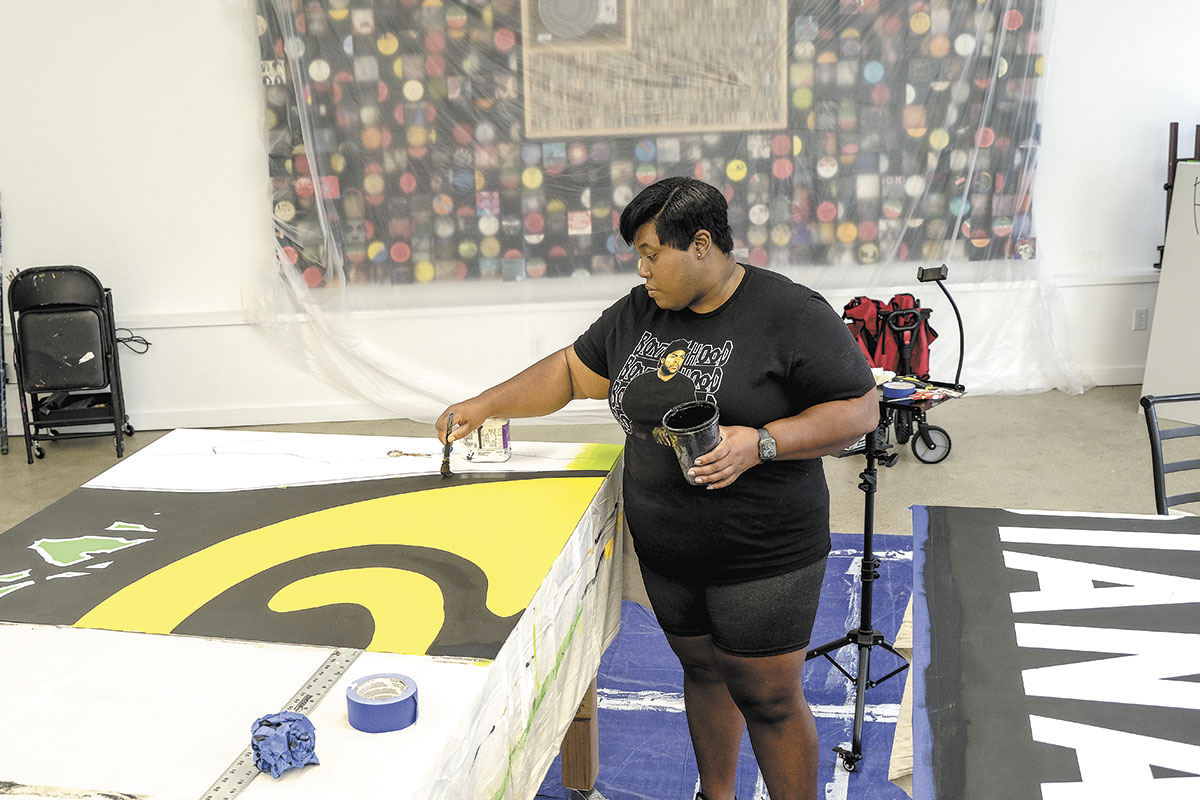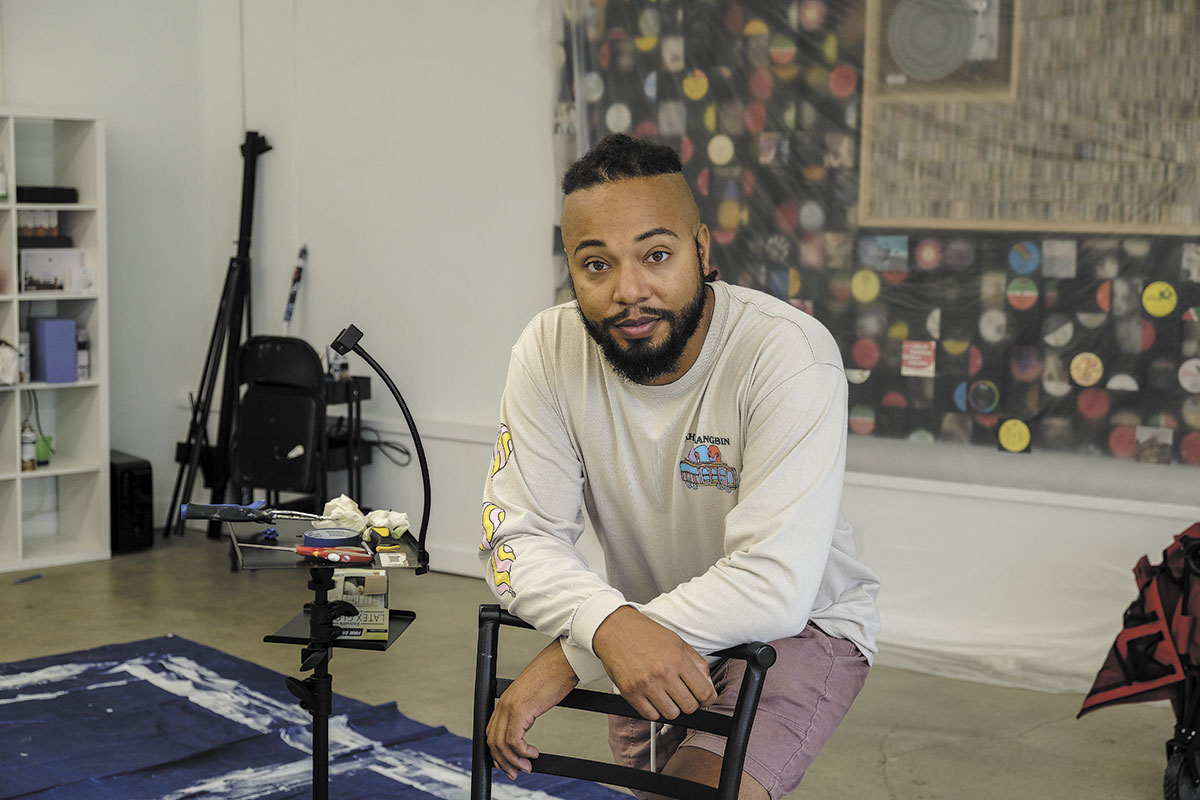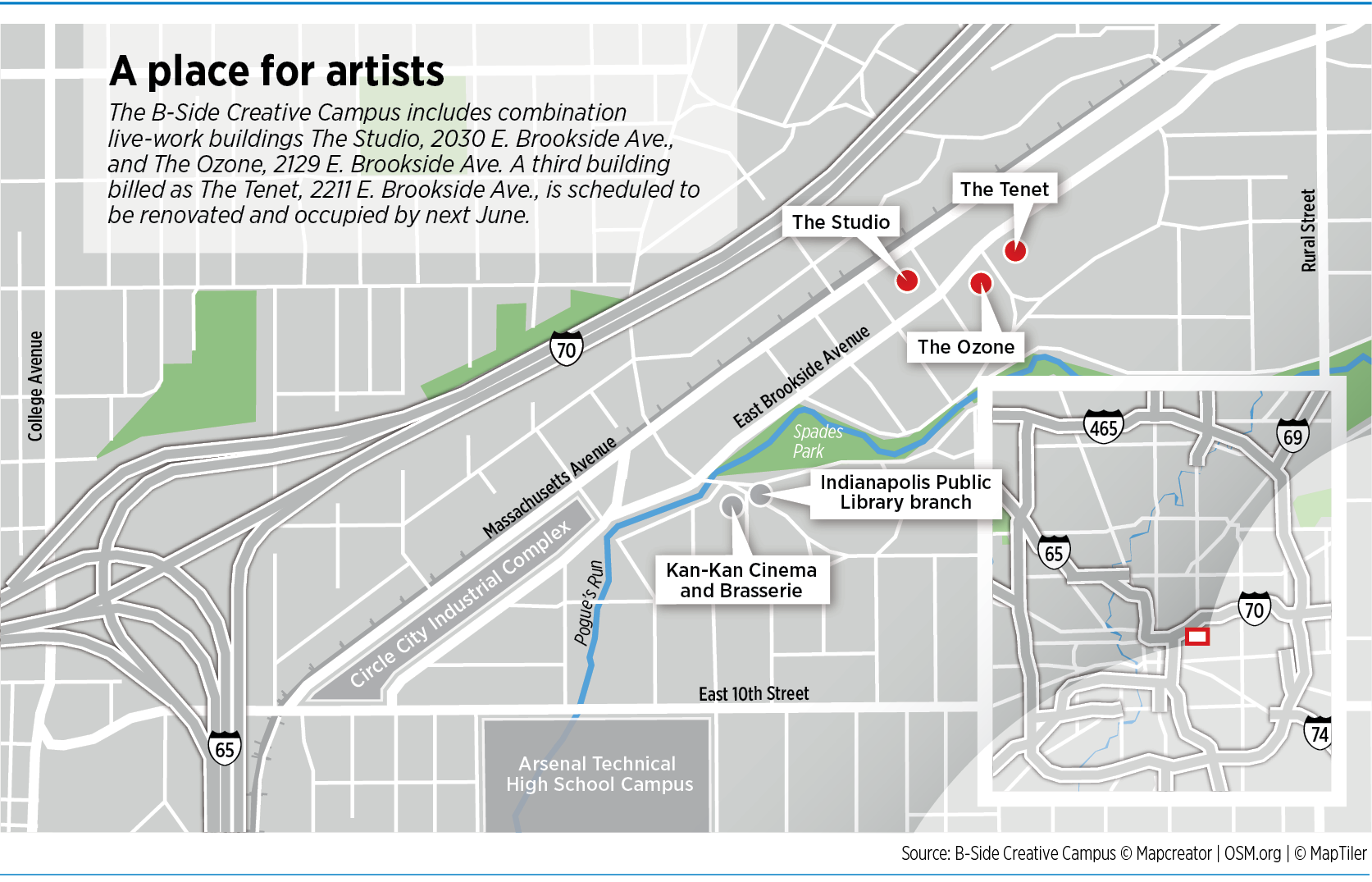Subscriber Benefit
As a subscriber you can listen to articles at work, in the car, or while you work out. Subscribe Now
The idea to help fellow artists and spruce up a street near Brookside and Spade parks came to Lobyn Hamilton after he moved into a former grocery store in the neighborhood where he spent the earliest years of his life.
Hamilton, an internationally recognized artist known for creating portraits and sculptures from fragments of vinyl records and album covers, purchased a fixer-upper built in 1910 that required months of HVAC and plumbing work.
“I knew the neighborhood was safe because we were keeping six windows open at night,” said Hamilton, who used the building as a live/work space from 2017 to 2019.
According to IUPUI’s Polis Center, the poverty rate on the near-east side was 34% in 2019. Nevertheless, Hamilton saw property values rise in areas between his place and downtown, and he predicted the trend would arrive soon enough at East Brookside Avenue, south of Massachusetts Avenue and west of Rural Street.
As someone whose artwork was featured on multiple seasons of TV series “Empire” and who resides in the collections of rappers Kanye West and Nas, Hamilton had the financial means to influence the future of his neighborhood.
“You walk out the door and you think, ‘Wow, there’s so much potential here, and there’s still time to do something about it,’” Hamilton said. “I didn’t want to be on the opposite end, sitting on the sidelines and saying, ‘Aw, man, I wanted to buy that building.’”
So, Hamilton purchased two more structures and founded the B-Side Creative Campus.
He moved out of the former grocery store at 2030 E. Brookside Ave. and renamed it The Studio. The 1,240-square-foot space was reserved as a combination live/work space for an established artist paying market-rate rent to B-Side.
A building that’s been home to church congregations and a candy store, 2129 E. Brookside Ave., was renamed The Ozone and enlivened by a multi-colored exterior paint job. Artist Tasha Beckwith moved into the 3,025-square-foot Ozone this month, and her rent and utilities are fully subsidized by B-Side.
Up next on the renovation schedule is a dilapidated house at 2211 E. Brookside Ave. that’s been renamed The Tenet. Hamilton said the 4,000-square-foot building will become a literary residence next summer for screenwriters, novelists, dissertation writers and poets who pay below-market rate to B-Side.
“It’s a neighborhood project where I came up,” Hamilton said of the creative campus. “We were just able to do what a lot of people regularly do, which is take care of your community.”

Hamilton estimates he’s invested more than $350,000 from his art sales into B-Side. Overall, he said, $600,000 has been spent in personal and partnership funds across the past six years.
The B-Side team includes urban planner and strategist Danicia Malone, who’s pursuing a doctorate in geography and urban studies at Temple University, and development specialist Rishard Allen, equitable initiatives officer for The Indianapolis Foundation.
Although Hamilton speaks modestly of the project, its financial backstory alone is noteworthy. “Black creative capital,” in Hamilton’s words, covered the costs of amassing the Studio, Ozone, Tenet and two greenspace lots from November 2016 to April 2020.
“The Brookside and Spades Park area just needed love and care,” Malone said. “Lobyn is providing that. He will say it’s normal, but it’s honestly quite unique. I hope to see more models like this continue to emerge.”
Tenant and friend
A high-profile art project is being assembled at the recently renovated Ozone. Beckwith is crafting a mural of entrepreneur Madam C.J. Walker that will be placed on the exterior of the Martens Building at 315 N. Senate Ave. downtown.
Because the building has historic protections, Beckwith said, a mural can’t be applied directly to its bricks. She’s preparing 55 aluminum composite sheets that will form one large image that reconfigures a temporary Walker mural Beckwith installed at the Civic Plaza of Indianapolis International Airport in 2021.
Beckwith, who graduated from Manual High School in 2000, said Hamilton, a 2003 graduate of Franklin Central High School, made good on a pledge that she would be the first B-Side artist to live in the subsidized space.
“The burden is lifted when you don’t have to worry about finances or a place to live,” said Beckwith, who previously lived with her mother on the far-west side.
In 2010, Beckwith and Hamilton showed their respective work as part of the annual Flava Fresh exhibition at the Indianapolis Artsgarden. Hamilton described Beckwith as a valued collaborator in his art.
“I didn’t get to this point without her,” he said. “I believe first you have to acknowledge those who helped you.”
In addition to subsidizing rent and utilities at The Ozone for one year, B-Side is giving Beckwith access to “creative care” amenities such as memberships at North Mass Boulder gym and Kan-Kan Cinema and Brasserie.
Hamilton said the amenities are offered rather than monetary perks because he wants the services to be used.
“I know if you give me $10,000 and say, ‘Go take care of yourself,’ I’m going to spend it on a computer and things that actually provide me more work and not necessarily more rejuvenation,” he said.
There are no strings attached to being a B-Side tenant. Artists don’t have commitments to exhibit new work or file progress reports.
“It’s really about taking a load off of the artist, recognizing that, in the creative sector, artists are one of the most overused professional groups of people,” Malone said. “But they receive so few benefits.”
“Let’s try to treat our creatives a little bit better in Indianapolis, just a little bit,” Hamilton said.
Beckwith, who’s considering making sculptures of the female form after completing the Walker mural, said The Ozone represents the first legitimate studio space she’s had in her career.
She described the live/work space as a “dream come true.”
“I hope I can reach the heights Lobyn has reached in my career, and I’d like to pay it forward by creating programs or even a residency for other artists coming up in the city,” Beckwith said.

Looking to grow
An artist who paid rent at The Studio for three years left the space after a motorist drove into a front corner of the building, Hamilton said. Once the building is repaired, B-Side plans to open applications for a new resident artist.
Meanwhile, B-Side is negotiating to buy a fourth building.
“The seller knows my position in the neighborhood, so he’s attempting to charge me triple,” Hamilton said. “It’s complex. We’re creating our own price-out in this particular manner. But we’re also creating more value and pride in the neighborhood. That’s infectious.”
Within B-Side’s mission statement on restorative creative development, the campus aspires to challenge “blight, housing insecurity and financial immobility.”
According to online real estate brokerage Redfin, houses near B-Side have estimated values ranging from $66,000 to $130,000.
“Can we subsidize a place that now costs $160,000 and needs $100,000 in it? No, we can’t,” Hamilton said. “But there was a time where you were able to get spaces and parcels low enough to be able to make those purchases.”

Cassie Richardson, an associate broker at Pursuit Realty, works with Hamilton when he seeks desirable properties for B-Side.
She said it’s a positive that Hamilton has been a visible presence in the neighborhood for more than five years.
“People question your motives, because Indianapolis is an affordable place for investors,” Richardson said. “A lot of people in Indianapolis are aware of that. We’re not going to undercut people or trick them, but we also want to pay fair market value. We’re not trying to disrupt the neighborhood. We’re trying to add to it.”
Hamilton said he understands why residents are skeptical about B-Side.
“You don’t want the neighborhood to be a specific way, so you do something about it,” he said. “But it encroaches on other people. No. 1, they don’t think the person who’s doing this is from the neighborhood. No. 2, they definitely don’t think the person is a creative.”
More than ‘seedlings’
Hamilton isn’t the first artist to buy property with the intent of helping fellow artists. In Chicago, artist Theaster Gates launched the Rebuild Foundation in 2009 with a focus on offering affordable spaces in under-resourced communities.
In Indianapolis, Big Car Collaborative has renovated 16 homes in the Garfield Park neighborhood for its Artist and Public Life Residency.
Malone, who served as program manager for the Artist and Public Life Residency when it debuted in 2017, said Big Car’s project emphasizes financial equity for artists who want to own homes, while B-Side is built upon the concept of providing creative care for artists.
Hamilton said he’s interested in finding out whether an individual artist can design a place for fellow artists. But he said he doesn’t believe gatekeepers in the city’s cultural community are keen on the idea.
“No one wants that,” said Hamilton, who then offered a recap of naysaying he’s encountered: “We need you for a specific task. We don’t see you as being in these traditional spaces of ownership, and definitely not design. There’s architects for that. You’re supposed to be here as the fertile ground and the seedlings. Someone else is supposed to come by and reap the harvest.”
Hamilton said he had a positive experience with the Herbert Simon Family Foundation, a rare external contributor in the B-Side story so far.
“It took a couple of phone calls and a developmental plan,” he said. “I asked for a number. We received that exact number, and they didn’t require us to be at the behest of the funder.”
Similar to his unconventional career in which he breaks vinyl records to create art, Hamilton sidestepped traditional systems and institutions to establish B-Side.
“I’m going to be over here on my own, and I’m going to have to build the thing that I don’t see out here,” he said.•
Please enable JavaScript to view this content.

